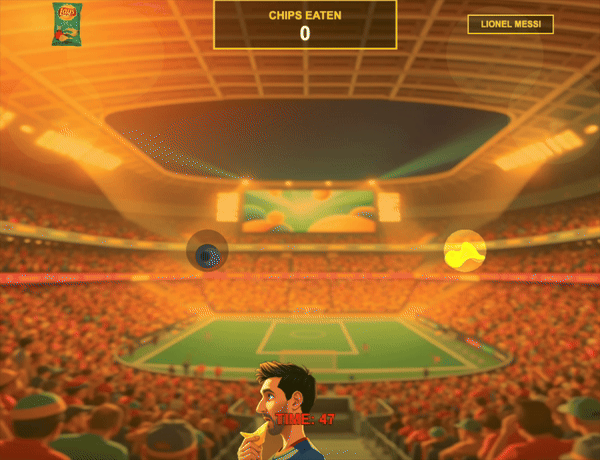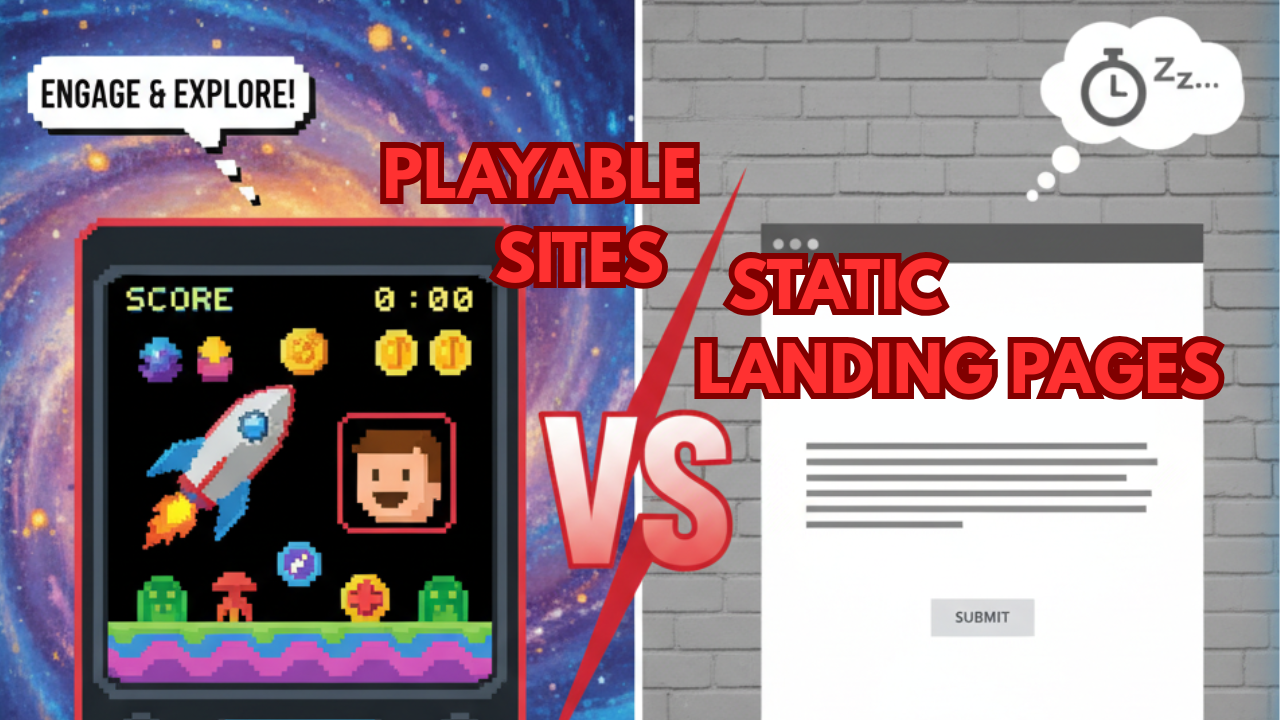Snack brands thrive on attention and fandom. Static landing pages are fast to ship, but they don’t exactly spark joy.
In fact, nearly two out of three marketers report that their average landing page conversion rate is less than 10%. That means most static landing pages struggle to convert even when traffic is high.
So we asked: what if Lay’s ran a campaign where fans played as a Messi-like striker racing to eat chips against the clock?
Why We Simulated This
The idea is backed by data: interactive formats consistently outperform static. For example, Interact found that for quizzes, 40.1% of people who click “start” go on to submit their information, and 65% complete the full experience. That level of engagement is difficult to achieve with a static landing page.
We didn’t put ad spend behind this test. Instead, we simulated the campaign design, user flow, and reporting output to illustrate how brands could structure a split-test between an interactive microsite and a static landing page.
The Campaign Concept
We mocked up two versions of a hypothetical Lay’s promo:
- Static Landing Page
- Headline: “Order Lay’s Online & Save 10%.”
- Copy block, hero image, order form.
- Interactive Microsite (Built in Rosebud AI)
- A Messi-style footballer runs across the screen eating Lay’s chips.
- Players have 60 seconds to eat as many chips as possible.
- Reward Flow:
- Score ≥ X chips → instant 10% discount code.
- Enter email → unlock 2 free bags of Lay’s with the next order.

Simulated Split-Test Plan
If Lay’s ran this for real, the setup would look like:
- Traffic Split: 50/50 between variants via Meta Ads.
- Audience: Snack fans + sports fans (e.g. EU/LatAm).
- Duration: 2–3 weeks.
- Primary Metric: Cost per Lead (CPL).
- Secondary Metrics: Avg. session time, discount redemption, CTR to order.
Measurement Setup (GA4 + Ads)
Events to Track
page_view(variant ID).game_start(microsite).chips_eaten(numeric).discount_redeem.email_submit.order_cta_click.
If you’re setting this up from scratch, Google has a solid walkthrough on how to configure events in GA4: Track Events. Following their setup ensures you’re capturing session engagement and conversions correctly before layering on campaign analysis.
Sample Report (Simulated Data)
⚠️ Note: These results are simulated — not actual ad spend. They demonstrate how the real reporting could look if Lay’s ran this split-test.
Try It Yourself: Remix the Template
We’ve published the base game template so you can remix it for your own campaign:
👉 Remix the Lay’s Game Template or explore the full Rosebud Marketing Template Library to adapt the same mechanic for your brand.
This template is flexible. Swap in your product, art style, or mechanics (e.g., collect coffees, dodge sneakers, catch cans). Within minutes, you can prototype your own microsite game.
For more real-world examples of how interactive media boosts conversion, see the Rosebud AI Blog, where we publish case studies and step-by-step guides.
Making Email Capture Production-Ready
Right now, the template handles email collection in development mode only:
- When a user enters their email and clicks “SUBMIT,” the address is just printed to the browser’s developer console with
console.log(). - Nothing is saved permanently.
This is intentional. Connecting directly to a CRM from the client-side isn’t secure (it would expose API keys to anyone who inspects the page).
The secure approach:
- The Game (Client): When the user submits their email, the game sends it via
fetch()to a secure backend endpoint (e.g.,https://your-api.com/subscribe). - Your API (Server): This service safely holds your CRM credentials and relays the email to your CRM (HubSpot, Klaviyo, Salesforce, etc.).
If you’re new to building APIs, check out how to build an API for a clear walkthrough of designing, securing, and deploying a minimal backend. This is exactly what you’d need to turn the demo into a production-ready system.
👉 In other words: Rosebud can provide the client-side “send” logic, but you’ll need a lightweight backend service to securely complete the integration. You can integrate the specific code snippet into any Rosebud template to move from prototype to production-ready campaign.
What the Simulation Shows
Our modeled results suggest the interactive microsite could clearly outperform the static landing page:
- 2.6× more emails captured (10.9% vs 4%).
- 63% lower CPL ($11 vs $30).
- 4× longer engagement (74s vs 18s).
These simulated findings are in line with broader research. Typeform reports that companies using interactive content see a 94% increase in views and 52.6% more engagement compared to static formats. In their analysis, even simple product recommendation quizzes boost conversions.
Key Takeaways for CPG Marketers
- Prototype first. Use Rosebud templates to test ideas before committing spend.
- Stack incentives. Discounts drive first orders; free product drives emails + loyalty.
- Plan integration early. Set up a backend API to securely handle email capture.
- Trust the numbers. With quiz conversion rates, interactive experiences simply work better than static pages.
Final Thoughts
This was a simulated case study, not a live ad campaign. But the takeaway is clear: interactivity consistently outperforms static formats. With Rosebud, you can remix a template, link it securely to your CRM, and see if play beats plain copy for your next launch.









